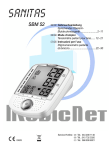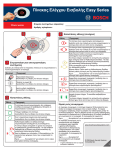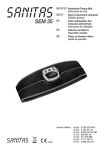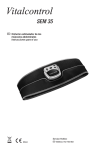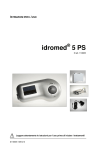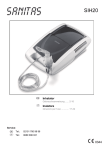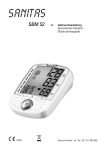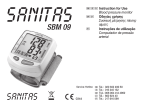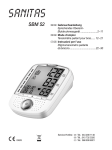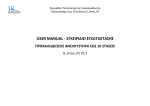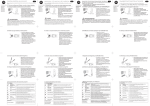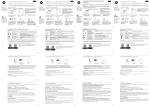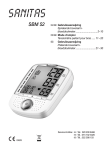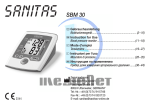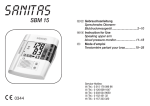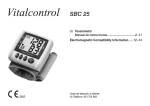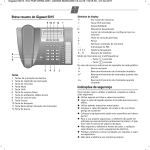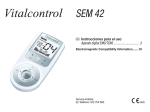Download SBM 52 G W Instruction for Use Speaking upper arm blood pressure
Transcript
SBM 52 0483 G W Instruction for Use Speaking upper arm blood pressure monitor ...................2 –10 K W Οδηγίες χρήσης Ομιλούσα συσκευή μέτρησης της αρτηριακής πίεσης................. 11 – 20 P Instruções de utilização Medidor de tensão arterial falante 21 – 30 Service-Hotline: K Τηλ.: 008 004 414 4962 W Tel.: 800 924 40 P Tel.: 217 616 099 G W ENGLISH Please read these instructions for use carefully and keep them for later use, be sure to make them accessible to other users and observe the information they contain. 1. Getting to know your instrument The upper arm blood pressure monitor is used for non-invasive measurement and monitoring of adults’ arterial blood pressure. You can use it to measure your blood pressure quickly and easily, storing the results and displaying the progression of readings together with the average. A warning is issued for anyone suffering from cardiac arrhythmia. The values determined are classified and graphically evaluated according to WHO guidelines. Keep these instructions carefully for further use and also let other users have access to them. 2. Important information Advice on use • Always measure your blood pressure at the same time of day, in order to ensure that values are comparable. • Relax for approx. 5 minutes before each measurement. • You should wait five minutes before measuring a second time. • The readings that you take may only be used for information purposes – they are not a substitute for a medical examination! Discuss your results with the doctor. Never use them to make medical decisions independently (e.g. regarding medication and dosage thereof). • There may be incorrect measurements where there is cardiocirculatory disease, as well as with very low blood pressure, circulatory disorders, dysrhythmia and other preexisting diseases. • Only use the instrument on persons whose upper arm has the right circumference for the instrument. • You can operate the blood pressure monitor with both batteries and mains. Note that it is only possible to save data when your blood pressure monitor is receiving power. As soon as the batteries wear out or you disconnect the mains adapter from the mains, the blood-pressure instrument loses the date and time. • The automatic switch-off function switches off the blood pressure monitor in order to preserve the batteries, if no button is pressed within one minute. Storage and Care • The blood pressure monitor is made up of precision electronic components. Accuracy of readings and the instrument’s service life depend on careful handling. – You should protect the device from impact, moisture, dirt, major temperature fluctuations and direct exposure to the sun’s rays. – Never drop the device. – Do not use near strong electromagnetic fields, i.e. keep it away from any radio systems and mobile phones. – Only ever use the cuffs provided with the monitor or original replacement cuffs. Otherwise erroneous results will be recorded. • Do not press any buttons until the cuff is in position. • If the instrument is not used for any length of time, we recommend removing the batteries. Advice on batteries • Batteries can be fatal if swallowed. You should therefore store the batteries and products where they are inaccessible to small children. If a battery has been swallowed, call a doctor immediately. 2 • Batteries should not be charged or reactivated with any other means, nor should they be taken apart, thrown in the fire or short-circuited. • Remove the batteries from the instrument if they are worn out or if you are not going to use the instrument for any length of time. This prevents any damage as a result of leakage. Always replace all the batteries at the same time. • Never use different types of battery, battery brands or batteries with different capacities. You should preferably use alkaline batteries. Repair and disposal • Batteries do not belong in domestic refuse. Used batteries should be disposed of at the collection points provided. • Never open the instrument. If these instructions are not heeded, the warranty will be null and void. • Never attempt to repair the instrument or adjust it yourself. We can no longer guarantee perfect functioning if you do. • Repairs may only be performed by Customer Service or authorized dealers. However, always check the batteries and replace them if necessary prior to making any complaint. • The appliance should be disposed of according to Regulation 2002/96/EC – WEEE (Waste Electrical and Electronic Equipment). In case of queries, please contact the municipal authorities responsible for waste disposal in your area. 3. Unit description Information on the display: 2 3 1 8 7 9 1 11 10 2 6 3 4 10 5 4 5 9 6 8 1. Cuff 2. Cuff line 3. Cuff connector 4. START/STOP button 5. function buttons 6. LED WHO scale 7. Connection for cuff connector 8. Display 9. Power socket (right side) 10. Memory button 7 1. Inflate , release air 2. Systolic pressure 3. Memory display: average value ( morning ( ), evening ( ) 4. Diastolic pressure 5. User memory 6. Calculated pulse value 7. Cardiac arrhythmia symbol 8. Time and date 9. WHO classification 10. Memory space number 11. Battery replacement symbol 3 ), 4. Preparing the measurement Insert the batteries • Open the battery compartment lid. • Insert four 1.5 V AA (alkaline type LR6) batteries. Make sure that the batteries are inserted with the correct polarity, according to the label. Do not use rechargeable batteries. The message “The device is ready for use. You may start measuring.” is displayed. • Close the battery compartment lid again carefully. • With inserted batteries, the unit permanently displays the time and date. 4 x AA (LR6) 1,5 V and appear, no further measurements can be If the the low battery indicator performed. The device will announce: “Battery weak.” Please replace all batteries. Once the batteries have been removed from the unit, the date, time and language must be set again. Used batteries should not be disposed of in normal household waste. Dispose of them via your electronics retailer or your local recycling point. You are legally obligated to do so. Note: The codes below are printed on batteries containing harmful substances: Pb: battery contains lead, Cd: battery contains cadmium, Hg: battery contains mercury. Set date, time and language This menu allows you to set the following functions, one after another. Date Time Language Volume It is essential to set the date and time. Otherwise, you will not be able to save your measured values correctly with a date and time and access them again later. The time is displayed in 24-hour format. In addition, the device has 3 language settings. The device is set to English when supplied to the customer. Language Date/Time If you press and hold the function buttons , you can set the values more quickly. • Switch on the device with the Start/stop button. • Press and hold the Memory button for 5 seconds. The year flashes on the display. • Set the year with the function buttons and confirm with the Memory button . • Set the month, day, hour and minutes and confirm each setting with the Memory button . The language will flash on the display . • You can select the following languages with the function buttons = English = Greek = Portuguese = Language off Confirm your selection with the Memory button . = Language off means that there is no voice output and therefore no acoustic playback. 4 Voice output The device is ready for use. You may start measuring. : English Ελληνικά Português Volume Voice output Volume level Vo3 flashes on the display. • You can set the volume of the selected language using the function buttons : Vo3 = loud Vo2 = medium Vo1 = quiet Confirm your selection with the Memory button . Operation with the power supply unit You can also operate this device with a power supply unit. When doing so, there must not be any batteries in the battery compartment. The power supply unit can be obtained from specialist retailers or from the service address using order number 071.30. • To prevent possible damage to the device, the blood pressure monitor must only be used with the power supply unit described here. • Insert the power supply unit into the connection provided for this purpose on the right-hand side of the blood pressure monitor. The power supply unit must only be connected to the mains voltage that is specified on the type plate. • Then insert the mains plug of the power supply unit into the mains socket. • After using the blood pressure monitor, unplug the power supply unit from the mains socket first and then disconnect it from the blood pressure monitor. As soon as you unplug the power supply unit, the blood pressure monitor loses the date and time setting but the saved measured values are retained. 5. Measuring blood pressure Please ensure the unit is at room temperature before measuring. Attach the cuff Place the cuff on to the bare left upper arm. The circulation of the arm must not be hindered by tight clothing or similar. The cuff must be placed on the upper arm so that the bottom edge is positioned 2 – 3 cm above the elbow and over the artery. The line points to the centre of the palm. Now tighten the free end of the cuff, but make sure that it is not too tight around the arm and close the Velcro fastener. The cuff should be fastened so that two fingers fit under the cuff. Now insert the cuff line into the connection for the cuff connector. Caution: The unit may only be operated with the original cuff. The cuff is suitable for an arm circumference of 22 to 36 cm. Adopt the correct posture • Before every measurement, relax for about five minutes. Otherwise deviations can occur. • You can perform the measurement while sitting or lying. Make sure that the cuff is at heart level. • To avoid falsifying the measuring result, it is important to remain still during the measurement and not to speak! 5 Selecting memory Voice output when voice function is active User memory • Switch on the device with the Start/stop button. When the device is switched off, the time and date are permanently displayed. • Select the desired user memory by pressing the function buttons . The device is ready for use. You may start measuring. User memory 1 User memory 2 User memory 3 User memory 4 You have 4 memories, each with 30 memory spaces to store the measurements of 4 different people separately. Performing the blood pressure measurement Measurement Voice output when voice function is active • As described before, attach the cuff and adopt the posture in which you want to perform the measurement. • Switch on the device with the Start/stop button. • A display check is performed, during which all display segments light up. • Start the device with the Start/stop button. The memory space that will be used is displayed. • The cuff is inflated to 180 mmHg. The cuff’s air pressure is slowly released. If a tendency for high blood pressure is already recognised, the cuff is reinflated and the cuff’s pressure is increased again. As soon as a pulse is detected, the symbol flashes. Measuring can be cancelled at any time by pressing the Start/ stop button . • Systolic pressure, diastolic pressure and pulse measurements are displayed. The device is ready for use. You may start measuring. Systole ... mmHg Diastole ... mmHg Heart rate ... beats per minute According to the WHO guidelines your blood pressure is – optimal – normal – high to normal – shows slight hypertension – shows medium hypertension – shows strong hypertension Whilst the message is being displayed, the volume can be adjusted with the function buttons . • appears if the measurement could not be performed properly. Observe the chapter on error messages/trouble-shooting in these instructions for use and repeat the measurement. • The measurement is automatically stored. • The device switches off automatically after 1 minute. Wait at least 5 minutes before performing another measurement! 6 6. Evaluating results Cardiac arrhythmia: This unit can identify potential disruption of the heart rhythm when measuring and if necessary, indicates . If the voice function is activated, the device will anthis after the measurement with the symbol nounce: “A possible cardiac arrhythmia was found.” This can be an indicator for arrhythmia. Arrhythmia is an illness in which the heart rhythm is abnormal because of flaws in the bioelectrical system that regulates the heartbeat. The symptoms (skipped or premature heart beats, pulse being slow or too fast) can be caused by factors such as heart disease, age, physical make-up, excess stimulants, stress or lack of sleep. Arrhythmia can only be determined through an examination by your doctor. If the symbol is shown on the display after the measurement has been taken, it should be repeated. Please ensure that you rest for 5 minutes beforehand and do not speak or move during the measurement. If the symbol appears frequently, please consult your doctor. Self-diagnosis and treatment based on the measurements can be dangerous. Always follow your GP’s instructions. WHO classification: In accordance with the guidelines/definitions of the World Heath Organization, the measurements are classified and assessed according to the following table: Blood pressure value category Grade 3: severe hypertension Grade 2: moderate hypertension Grade 1: mild hypertension High normal Normal Optimal Systole (in mmHg) > = 180 160 – 179 140 – 159 130 – 139 120 – 129 < 120 Diastole (in mmHg) > = 110 100 – 109 90 – 99 85 – 89 80 – 84 < 80 Action seek medical attention seek medical attention regular monitoring by doctor regular monitoring by doctor self-monitoring self-monitoring Source: WHO, 1999 The bar chart on the display and the scale on the unit show which category the recorded BMI values fall into. If the values of systole and diastole fall into two different WHO categories (e.g. systole in the ‘High normal’ category and diastole in the ‘Normal’ category), the graphical WHO classification on the unit always shows the higher category; for the example given this would be ‘High normal’. 7. Saving, displaying and deleting measurements Whilst the message is being displayed, the volume can be adjusted with the function buttons . User memory Voice output when voice function is active The results of every successful measurement are stored together with the date and time. If there are more than 30 measurements, the oldest measurements are lost. • Switch on the device with the Start/stop • Select the desired user memory ( buttons . … button. ) by pressing the function 7 The device is ready for use. You may start measuring. User memory 1 User memory 2 User memory 3 User memory 4 Delete measured values Individual measured values Average values Voice output when voice function is active • Press the Memory button . The average value of all saved measured values in this user memory is displayed first . • If you press the Memory button again, the average value of the morning measurements for the last 7 days will be displayed (morning: 5 a.m. – 9 a.m., display ). • If you press the Memory button again, the average value of the evening measurements for the last 7 days will be displayed (evening: 6 p.m. – 8 p.m., display ). • If you continue to press the Memory button , the most recent individual measured values are displayed in turn with the date and time. Average count: Systole ... mmHg Diastole ... mmHg Heart rate ... beats per minute According to the WHO guidelines your blood pressure is ... Memory space ... Systole ... mmHg Diastole ... mmHg Heart rate ... beats per minute According to the WHO guidelines your blood pressure is ... • The measured values in the corresponding user memory can be deleted by switching on the device, selecting the desired user memory, pressing the Memory button and then pressing function buttons and simultaneously for 5 seconds . • To switch off, press the Start/stop button . • If you forget to switch off the unit, it will switch off automatically after 1 minute. All the counts in the memory have been erased. 8. Error message/trouble shooting In the event of errors, the error message _ appears on the display. Error messages can occur when 1. no pulse signal can be find ( ), 2. you move or talk during the measurement (in addition to , the cardiac arrhythmia icon the display), 3. the cuff is inflated for longer than 25 seconds ( ). 4. errors occur during measuring ( ), 5. inflation pressure is higher than 300 mmHg ( ). 6. the batteries are almost empty ( ). appears in In such cases, repeat the measurement. Ensure that you do not move or speak. If necessary, reinsert or replace the batteries. 9. Cleaning and storing the unit • Clean your blood pressure monitor carefully using a slightly damp cloth only. • Do not use any cleaning agents or solvents. • Under no circumstances should you hold the unit under water, as this can cause liquid to enter and damage the unit. • If you store the unit, no heavy objects should be placed on top of it. Remove the batteries. The cuff line should not be bent sharply. 8 10. Technical specifications Model no. Measurement method Measurement range SBM 52 Oscillometric, non-invasive blood pressure measurement on the upper arm pressure 0 – 300 mmHg, systolic 50 – 250 mmHg, diastolic 30 – 200 mmHg, pulse 30 –180 beats per minute Accuracy systolic ± 3 mmHg /diastolic ± 3 mmHg /pulse ± 5 % of the value shown Measurement inaccuracy Max. permissible standard deviation according to clinical testing: systolic 8 mmHg /diastolic 8 mmHg Memory 4 x 30 memory spaces Dimensions (L) 134 x (W) 102 x (H) 53 mm Weight Approximately 287 g Cuff size 22 to 36 cm Permissible operating temperature +10 °C to +40 °C, 30 – 85 % relative humidity Permissible storage temperature -5 °C to +50 °C, 10 – 85 % relative humidity Power supply 4 x 1.5 V AA batteries (alkaline type LR6) Battery life For approx. 250 measurements, depending on levels of blood pressure and pump pressure Accessories Storage pouch, instructions, 4 x 1.5 V AA batteries Protection class Internal supply, IPX0, no AP or APG, continuous operation Signs and symbols Application part type B Caution! Read the instructions for use! Manufacturer Technical information is subject to change without notification to allow for updates. • This unit is in line with the European Standard EN 60601-1-2 and is subject to particular precautions with regard to electromagnetic compatibility. Please note that portable and mobile HF communication systems may interfere with this unit. More details can be requested from the stated Customer Service address or found at the end of the instructions for use. • This unit is in line with the EU Medical Devices Directive 93/42/EC, the “Medizinproduktegesetz” (German Medical Devices Act) and European Standard EN1060-1 (non-invasive sphygmomanometers, Part 1: General requirements) and EN1060-3 (non-invasive sphygmomanometers, Part 3: Supplementary requirements for electro-mechanical blood pressure measuring systems). Power supply unit Model No. Input Output Supplier Protection FW7333SM/06 100 – 240 V, 50 – 60 Hz 6 V DC, 1150 mA, only in connection with Sanitas blood pressure monitor Friwo Gerätebau GmbH This device is double isolated and protected against short circuit and overload by a primary thermal fuse. The green LED lights under normal conditions. Make sure to take the batteries out of the compartment before using the adapter. double isolated / equipment class 2 9 Enclosures and Protective Covers Equipment enclosed to protect against contact with live parts, and with parts which can become live (finger, pin, hook test). The operator shall not contact the patient and the output plug of AC adaptor simultaneously. • The power supply unit FW7333SM/06 conforms to the specifications of IEC 60601-1: 2005. In addition, all configurations meet the requirements for medical electrical systems (see IEC 60601-1-1 or section 16 of the 3rd edition of IEC 60601-1). For more details, please contact customer services at the address indicated. 11. Warranty / Service centre We provide a 3-year warranty covering faults in materials or manufacture of the product from the purchase date. The warranty does not cover: • Damage resulting from improper use. • Wear parts. • Defects that were known to the customer at the time of purchase. • Damage for which the customer was responsible. This warranty does not affect the customer‘s legal rights. The customer must provide proof of purchase in order for any warranty claims within the warranty period to be honoured. Claims under the warranty within a period of 3 years from the date of purchase are honoured by Hans Dinslage GmbH, Riedlinger Str. 28, 88524 Uttenweiler, Germany. In the event of a warranty claim, the customer has the right to have the goods repaired by our own workshop or a workshop authorised by use. The device must not be opened for any reason. Opening or modifying the device invalidates the warranty. This warranty does not grant any additional rights to the customer. In many cases the reason for complaints is operating errors. They can be easily corrected by telephone. Please contact the service hotline. W Tel.: 800 924 40 10 K W ΕΛΛΗΝΙΚ Παρακαλούμε διαβάστε προσεκτικά όλες τις παρούσες οδηγίες χρήσης, φυλάξτε τις για μελλοντική χρήση, διαθέστε τις και σε άλλους χρήστες και τηρήστε τις υποδείξεις. 1. Γνωριμία Η συσκευή μέτρησης αρτηριακής πίεσης στον βραχίονα χρησιμεύει για τη μη επεμβατική μέτρηση και παρακολούθηση των τιμών αρτηριακής πίεσης ενηλίκων. Με αυτή μπορείτε να μετράτε γρήγορα και εύκολα την πίεση του αίματός σας, να τη διατηρείτε στη μνήμη και να παρακολουθείτε την εξέλιξη και τη μέση τιμή των τιμών μέτρησης. Η συσκευή σας προειδοποιεί σε περίπτωση που υπάρχουν διαταραχές του καρδιακού ρυθμού. Οι διαπιστούμενες τιμές ταξινομούνται σύμφωνα με τις οδηγίες του ΠΟΥ και αξιολογούνται με γράφημα. Φυλάξτε τις παρούσες οδηγίες χρήσης για μελλοντική χρήση και διαθέστε τις και σε άλλους χρήστες. 2. Σημαντικές οδηγίες Οδηγίες για τη χρήση • Μετράτε την αρτηριακή σας πίεση πάντοτε τις ίδιες ώρες της ημέρας, για να εξασφαλίζετε τη δυνατότητα σύγκρισης των τιμών. • Πριν από κάθε μέτρηση ηρεμείτε για περίπου 5 λεπτά! • Ανάμεσα σε δύο μετρήσεις πρέπει να περιμένετε 5 λεπτά! • Οι τιμές μέτρησης που διαπιστώσατε μπορούν να χρησιμοποιούνται μόνο για πληροφόρησή σας – δεν αντικαθιστούν την ιατρική εξέταση! Συζητήστε τις μετρήσεις σας με τον γιατρό, σε καμία περίπτωση μην αιτιολογείτε βάσει αυτών δικές σας ιατρικές αποφάσεις (π.χ. φάρμακα και δοσολογίες τους)! • Μπορεί να προκύψουν εσφαλμένες μετρήσεις σε περιπτώσεις ασθενειών του καρδιακού κυκλοφορικού συστήματος όπως επίσης σε περίπτωση πολύ χαμηλής αρτηριακής πίεσης, διαταραχών της κυκλοφορίας του αίματος και αρρυθμίας, καθώς και με άλλες ασθένειες. • Χρησιμοποιήστε τη συσκευή μόνο σε άτομα με την ενδεικνυόμενη περίμετρο βραχίονα για αυτήν τη συσκευή. • Μπορείτε να χρησιμοποιείτε τη συσκευή μέτρησης αρτηριακής πίεσης με μπαταρίες ή με μετασχηματιστή. Προσέξτε ότι η αποθήκευση των δεδομένων είναι δυνατή μόνον αν η συσκευή μέτρησης αρτηριακής πίεσης τροφοδοτείται με ρεύμα. Μόλις εξαντληθούν οι μπαταρίες ή αποσυνδεθεί ο μετασχηματιστής από το ρεύμα, η συσκευή μέτρησης αρτηριακής πίεσης χάνει την ημερομηνία και την ώρα. • Αν μέσα σε ένα λεπτό δεν ενεργοποιηθεί κάποιο πλήκτρο, ο μηχανισμός αυτόματης διακοπής απενεργοποιεί τη συσκευή μέτρησης αρτηριακής πίεσης, για εξοικονόμηση μπαταρίας. Υποδείξεις για Αποθήκευση και Φροντίδα • Η συσκευή μέτρησης αρτηριακής πίεσης αποτελείται από ηλεκτρονικά στοιχεία ακριβείας. Η ακρίβεια των τιμών μέτρησης και η διάρκεια ζωής της συσκευής εξαρτάται από την προσεκτική μεταχείρισή της: – Προφυλάξτε τη συσκευή από χτυπήματα, υγρασία, ρύπανση, έντονες διακυμάνσεις θερμοκρασίας και άμεση ηλιακή ακτινοβολία. – Μην αφήσετε τη συσκευή να πέσει. – Μη χρησιμοποιείτε τη συσκευή κοντά σε ισχυρά ηλεκτρομαγνητικά πεδία, κρατήστε τη μακριά από τηλεπικοινωνιακές εγκαταστάσεις ή κινητά τηλέφωνα. – Χρησιμοποιείτε μόνο τις παραδιδόμενες μαζί με τη συσκευή ή γνήσιες ανταλλακτικές μανσέτες. Σε αντίθετη περίπτωση, διαπιστώνονται λανθασμένες τιμές μέτρησης. • Μην πατάτε τα κουμπιά, εάν δεν έχει τοποθετηθεί η μανσέτα. • Εάν η συσκευή δεν χρησιμοποιείται για μεγάλο χρονικό διάστημα, συνιστάται να αφαιρούνται οι μπαταρίες. 11 Οδηγίες για τις μπαταρίες • Οι μπαταρίες μπορεί να θέσουν σε κίνδυνο τη ζωή σε περίπτωση κατάποσης. Γι‘ αυτό κρατήστε τις μπαταρίες και τα προϊόντα μακριά από μικρά παιδιά. Αν καταπιείτε μπαταρία, πρέπει να ζητήσετε αμέσως ιατρική βοήθεια. • Οι μπαταρίες δεν επιτρέπεται να φορτίζονται ή να επανενεργοποιούνται με άλλα μέσα, να αποσυναρμολογούνται, να πετάγονται στη φωτιά ή να βραχυκυκλώνονται. • Αφαιρέστε τις μπαταρίες από τη συσκευή όταν έχουν εξαντληθεί ή όταν δεν χρησιμοποιείτε επί μακρόν τη συσκευή. Έτσι αποφεύγετε τις βλάβες που μπορούν να προκύψουν από διαρροή. Πάντοτε να αντικαθιστάτε ταυτόχρονα όλες τις μπαταρίες. • Μη χρησιμοποιείτε διαφορετικούς τύπους μπαταριών, μάρκες μπαταριών ή μπαταρίες με διαφορετική χωρητικότητα. Χρησιμοποιείτε κατά προτίμηση αλκαλικές μπαταρίες. Οδηγίες για την επισκευή και την απόρριψη • Οι μπαταρίες δεν ανήκουν στα οικιακά απορρίμματα. Παρακαλούμε απορρίπτετε τις χρησιμοποιημένες μπαταρίες στις προβλεπόμενες γι‘ αυτό θέσεις συλλογής. • Μην ανοίγετε τη συσκευή. Σε περίπτωση μη τήρησης, παύει να ισχύει η εγγύηση. • Δεν επιτρέπεται η επισκευή ή η ρύθμιση της συσκευής από τον χρήστη. Σε αυτή την περίπτωση, δεν ισχύει πλέον η εγγύηση απρόσκοπτης λειτουργίας. • Επισκευές επιτρέπεται να πραγματοποιούνται μόνο από την υπηρεσία εξυπηρέτησης πελατών ή από εξουσιοδοτημένους εμπόρους. Προτού προβείτε σε κάποια καταγγελία, ελέγξτε τις μπαταρίες και, αν χρειαστεί, αντικαταστήστε τις. • Παρακαλείσθε να εκτελείτε την απορριμματική διαχείριση της συσκευής σύμφωνα με τη διάταξη για παλιές ηλεκτρικές και ηλεκτρονικές συσκευές 2002/96/EC–WEEE (Waste Electrical and Electronic Equipment). Σε περίπτωση που έχετε ερωτήσεις όσον αφορά την απορριμματική διαχείριση παρακαλείσθε να έρθετε σε επαφή με την αρμόδια δημοτική υπηρεσία. 12 3. Περιγραφή συσκευής Ενδείξεις στην οθόνη: 2 3 1 8 7 9 1 11 10 2 6 3 4 10 5 4 5 9 6 8 1. Μανσέτα 2. Σωλήνας μανσέτας 3. Βύσμα μανσέτας 4. Πλήκτρο START/STOP 5. Πλήκτρα λειτουργιών 6. LED Κλίμακα ΠΟΥ 7. Σύνδεση για το βύσμα της μανσέτας 8. Οθόνη 9. Σύνδεση για τον μετασχηματιστή (δεξιά πλευρά) 10. Πλήκτρο μνήμης 7 1. Φουσκώστε , απελευθερώστε αέρα 2. Συστολική πίεση 3. Ένδειξη μνήμης: Μέση τιμή ( ), το πρωί ( ), το απόγευμα ( ) 4. Διαστολική πίεση 5. Θήκη αποθήκευσης 6. Εξακριβωμένη τιμή παλμού 7. Σύμβολο διαταραχής καρδιακού ρυθμού 8. Ώρα και ημερομηνία 9. Κατάταξη ΠΟΥ 10. Αριθμός της θέσης μνήμης 11. Σύμβολο αλλαγής μπαταριών 4. Προετοιμασία μέτρησης 4 x AA (LR6) 1,5 V Τοποθετήστε τις μπαταρίες • Ανοίξτε το κάλυμμα της θήκης μπαταριών. • Τοποθετήστε τέσσερις μπαταρίες τύπου 1,5 V ΑΑ (αλκαλικές τύπου LR6). Προσέξτε οπωσδήποτε οι μπαταρίες να τοποθετηθούν με τη σωστή πολικότητα σύμφωνα με τη σήμανση. Μη χρησιμοποιείτε επαναφορτιζόμενες μπαταρίες. Ακούγεται η αναγγελία «Η συσκευή είναι έτοιμη. Μπορείτε να αρχίσετε τη μέτρηση». • Κλείστε πάλι προσεκτικά το κάλυμμα της θήκης μπαταριών. • Όταν είναι τοποθετημένες μπαταρίες, η συσκευή εμφανίζει διαρκώς την ώρα και την ημερομηνία. Αν εμφανίζεται η ένδειξη αντικατάστασης μπαταριών και , δεν είναι δυνατή η μέτρηση. Η συσκευή αναγγέλλει: «Χαμηλή μπαταρία.» Αντικαταστήστε όλες τις μπαταρίες. Μόλις αφαιρεθούν οι μπαταρίες από τη συσκευή, η ημερομηνία, η ώρα και η γλώσσα πρέπει να ρυθμιστούν εκ νέου. Οι εξαντλημένες μπαταρίες δεν ανήκουν στα οικιακά απορρίμματα. Απορρίψτε τις μέσω του ειδικού εμπόρου ηλεκτρικών ειδών ή του τοπικού σημείου συλλογής ανακυκλώσιμων υλικών. Αυτό είναι υποχρεωτικό από το νόμο. Υπόδειξη: Αυτά τα σύμβολα βρίσκονται στις μπαταρίες που περιέχουν βλαβερές ουσίες: Pb: Η μπαταρία περιέχει μόλυβδο, Cd: Η μπαταρία περιέχει κάδμιο, Hg: Η μπαταρία περιέχει υδράργυρο. Ρύθμιση ημερομηνίας, ώρας και γλώσσας Σε αυτό το μενού έχετε τη δυνατότητα να ρυθμίσετε διαδοχικά τις παρακάτω λειτουργίες: Ημερομηνία Ώρα Γλώσσα Ένταση ήχου 13 Πρέπει οπωσδήποτε να ρυθμίσετε ημερομηνία και ώρα. Μόνο έτσι μπορείτε να αποθηκεύσετε σωστά, με ημερομηνία και ώρα, και να ανακαλέσετε αργότερα τις τιμές μέτρησής σας. Η ώρα παριστάνεται σε 24ωρη μορφή. Η συσκευή διαθέτει επιπλέον 3 γλώσσες. Κατά την παράδοση η συσκευή είναι ρυθμισμένη στα Αγγλικά. Γλώσσα Ημερομηνία / Ώρα Αν κρατήσετε πιεσμένα τα πλήκτρα λειτουργίας , μπορείτε να ρυθμίσετε γρηγορότερα τις τιμές. • Ενεργοποιήστε τη συσκευή με το πλήκτρο ΕΝΑΡΞΗΣ/ΔΙΑΚΟΠΗΣ . • Κρατήστε πιεσμένο το πλήκτρο μνήμης για 5 δευτερόλεπτα. Στην οθόνη αναβοσβήνει η χρονολογία. • Ρυθμίστε το έτος με τα πλήκτρα λειτουργίας και επιβεβαιώστε με το πλήκτρο μνήμης . • Ρυθμίστε τον μήνα, την ημέρα, τις ώρες και τα λεπτά και επιβεβαιώνετε κάθε φορά με το πλήκτρο μνήμης . Στην οθόνη αναβοσβήνει η ένδειξη της γλώσσας . • Με τα πλήκτρα λειτουργίας μπορείτε να επιλέξετε τις ακόλουθες γλώσσες: = Αγγλικά = Ελληνικά = Πορτογαλικά = Απενεργοποίηση γλώσσας Ένταση ήχου Επιβεβαιώστε την επιλογή σας με το πλήκτρο μνήμης Ομιλία Η συσκευή είναι έτοιμη Μπορείτε να αρχίσετε τη μέτρηση. Αγγλικά Ελληνικά Πορτογαλικά . = Απενεργοποίηση γλώσσας σημαίνει ότι δεν γίνεται σύνθεση ομιλίας και κατά συνέπεια ούτε ηχητική αναπαραγωγή. Στην οθόνη αναβοσβήνει η ένδειξη της έντασης ήχου Vo3. • Με τα πλήκτρα λειτουργίας μπορείτε να ρυθμίσετε την ένταση ήχου της επιλεγμένης γλώσσας: Vo3 = δυνατή Vo2 = μεσαία Vo1 = χαμηλή Επιβεβαιώστε την επιλογή σας με το πλήκτρο μνήμης . Λειτουργία με τον μετασχηματιστή Μπορείτε να χρησιμοποιήσετε αυτή τη συσκευή και με μετασχηματιστή. Για να γίνει αυτό δεν επιτρέπεται να υπάρχουν μπαταρίες στη θήκη μπαταριών. Ο μετασχηματιστής διατίθεται με αριθμό παραγγελίας 071.30 στα εξειδικευμένα καταστήματα ή στη διεύθυνση εξυπηρέτησης πελατών. • Η συσκευή μέτρησης αρτηριακής πίεσης επιτρέπεται να λειτουργεί μόνο με τους μετασχηματιστές που περιγράφονται εδώ, για να αποφευχθεί πιθανή βλάβη της. • Συνδέστε τον μετασχηματιστή στην προβλεπόμενη γι’ αυτό το σκοπό σύνδεση στη δεξιά πλευρά της συσκευής μέτρησης αρτηριακής πίεσης. Ο μετασχηματιστής επιτρέπεται να συνδέεται μόνο με την τάση δικτύου που αναγράφεται στην πινακίδα τύπου. • Στη συνέχεια συνδέστε το βύσμα του μετασχηματιστή με την πρίζα. • Μετά τη χρήση της συσκευής μέτρησης αρτηριακής πίεσης, αποσυνδέστε τον μετασχηματιστή πρώτα από την πρίζα και στη συνέχεια από τη συσκευή μέτρησης αρτηριακής πίεσης. Μόλις αποσυνδέσετε τον μετασχηματιστή από την πρίζα, η συσκευή μέτρησης αρτηριακής πίεσης χάνει την ημερομηνία και την ώρα. Εντούτοις οι αποθηκευμένες τιμές μέτρησης διατηρούνται. 14 5. Μέτρηση της πίεσης του αίματος Πριν από τη μέτρηση φέρετε τη συσκευή σε θερμοκρασία δωματίου. Τοποθέτηση της μανσέτας Τοποθετήστε τη μανΗ μανσέτα πρέπει να σέτα στον γυμνωμένο τοποθετείται στον βρααριστερό βραχίονα. Η χίονα έτσι ώστε η κάτω κυκλοφορία του αίμαπλευρά της να βρίσκετος του βραχίονα δεν ται 2 – 3 cm πάνω από πρέπει να δυσχεραίτην εσωτερική γωνία του νεται από πολύ στενά αγκώνα και πάνω από ρούχα ή παρόμοια. την αρτηρία. Ο σωλήνας κατευθύνεται προς το μέσο της επιφάνειας του βραχίονα. Βάλτε τώρα σφιχτά (αλλά όχι πολύ) το ελεύθερο άκρο της μανσέτας γύρω από τον βραχίονα και κλείστε το βέλκρο. Η μανσέτα πρέπει να είναι τόσο σφιχτή ώστε να χωρούν μόνο δύο δάχτυλα κάτω από αυτήν. Τοποθετήστε τώρα τον σωλήνα της μανσέτας στη σύνδεση για το βύσμα της μανσέτας. Προσοχή: Η συσκευή επιτρέπεται να λειτουργεί μόνο με τη γνήσια μανσέτα. Η μανσέτα είναι κατάλληλη για περίμετρο βραχίονα από 22 έως 36 cm. Λάβετε σωστή θέση σώματος • Πριν από κάθε μέτρηση ηρεμείτε για περίπου 5 λεπτά! Διαφορετικά, μπορεί να παρουσιαστούν αποκλίσεις. • Μπορείτε να κάνετε τη μέτρηση καθιστός ή ξαπλωμένος. Προσέχετε σε κάθε περίπτωση ώστε η μανσέτα να βρίσκεται στο ύψος της καρδιάς. • Για να μην αλλοιώσετε το αποτέλεσμα της μέτρησης, είναι σημαντικό να είστε χαλαροί κατά τη διάρκεια της μέτρησης και να μη μιλάτε. Επιλογή μνήμης Σύνθεση ομιλίας όταν είναι ενεργοποιημένη η λειτουργία γλώσσας Μνήμη χρήστη • Ενεργοποιήστε τη συσκευή με το πλήκτρο ΕΝΑΡΞΗΣ/ΔΙΑΚΟΠΗΣ . Η συσκευή είναι έτοιμη Όταν η συσκευή είναι απενεργοποιημένη, η ώρα και η ημερομη- Μπορείτε να αρχίσετε τη μέτρηση. νία εμφανίζονται μόνιμα. • Επιλέξτε τη θέση μνήμης χρήστη που θέλετε πιέζοντας τα πλήκτρα λειτουργίας . Θήκη αποθήκευσης 1 Θήκη αποθήκευσης 2 Θήκη αποθήκευσης 3 Θήκη αποθήκευσης 4 Έχετε 4 μνήμες με 30 θέσεις μνήμης η κάθε μία για να αποθηκεύετε χωριστά τα αποτελέσματα μέτρησης 4 διαφορετικών ατόμων. 15 Εκτέλεση της μέτρησης αρτηριακής πίεσης Σύνθεση ομιλίας όταν είναι ενεργοποιημένη η λειτουργία γλώσσας • Τοποθετήστε όπως περιγράφηκε παραπάνω τη μανσέτα και πάρτε τη στάση στην οποία θέλετε να εκτελέσετε τη μέτρηση. • Ενεργοποιήστε τη συσκευή με το πλήκτρο ΕΝΑΡΞΗΣ/ΔΙΑΚΟΠΗΣ . • Η οθόνη ελέγχεται με το άναμμα όλων των στοιχείων της οθόνης. • Θέστε τη συσκευή σε λειτουργία με το πλήκτρο ΕΝΑΡΞΗΣ/ΔΙΑΚΟΠΗΣ . Εμφανίζεται η θέση μνήμης που θα καταληφθεί. • Η μανσέτα φουσκώνεται στα 180 mmHg. Η πίεση αέρα στη μανσέτα μειώνεται αργά. Σε περίπτωση που ήδη αναγνωρίζεται τάση για υψηλή αρτηριακή πίεση, γίνεται πάλι φούσκωμα και η πίεση της μανσέτας αυξάνεται ξανά. Μόλις αναγνωριστεί σφυγμός, αναβοσβήνει το σύμβολο . Μπορείτε ανά πάσα στιγμή να διακόψετε τη μέτρηση πιέζοντας το πλήκτρο ΕΝΑΡΞΗΣ/ΔΙΑΚΟΠΗΣ . • Εμφανίζονται τα αποτελέσματα μέτρησης της συστολικής πίεσης, της διαστολικής πίεσης και του σφυγμού. Η συσκευή είναι έτοιμη Μπορείτε να αρχίσετε τη μέτρηση. Συστολή ... Χιλιοστά υδραργύρου Διαστολή ... Χιλιοστά υδραργύρου Μέτρηση Παλμοί της καρδιάς ... Σφυγμοί ανά λεπτό Σύμφωνα με τις οδηγίες του Παγκόσμιου Οργανισμού Υγείας η πίεσή σας είναι – Βέλτιστη – Κανονική – Υψηλή κανονική – Ελαφρά υπέρταση – Μέτρια υπέρταση – Σοβαρή υπέρταση Κατά τη διάρκεια της αναγγελίας μπορείτε να αλλάξετε την ένταση ήχου με τα πλήκτρα λειτουργίας . • Το εμφανίζεται σε περίπτωση που η μέτρηση δεν μπόρεσε να εκτελεστεί κανονικά. Τηρήστε το κεφάλαιο Αναγγελία σφάλματος/ Διόρθωση σφάλματος στις παρούσες Οδηγίες χρήσης και επαναλάβετε τη μέτρηση. • Το αποτέλεσμα της μέτρησης αποθηκεύεται αυτόματα. • Η συσκευή τίθεται εκτός λειτουργίας αυτομάτως μετά από 1 λεπτό. Περιμένετε τουλάχιστον 5 λεπτά πριν κάνετε νέα μέτρηση! 6. Αξιολόγηση αποτελεσμάτων Διαταραχές του καρδιακού ρυθμού: Αυτή η συσκευή μπορεί κατά τη μέτρηση να αναγνωρίζει ενδεχόμενες διαταραχές του καρδιακού ρυθμού . Όταν είναι ενεργοποιημένη η και τις υποδεικνύει κατά περίπτωση μετά τη μέτρηση με το σύμβολο λειτουργία ομιλίας, η συσκευή αναγγέλλει: «Διεγνώσθη πιθανή αρρυθμία». Αυτό μπορεί να είναι ένδειξη αρρυθμίας. Η αρρυθμία είναι μια ασθένεια κατά την οποία ο ρυθμός της καρδιάς είναι ανώμαλος λόγω σφαλμάτων στο βιοηλεκτρικό σύστημα το οποίο ελέγχει τον καρδιακό παλμό. Τα συμπτώματα (διαλείψεις ή 16 πρόωροι καρδιακοί παλμοί, βραδύτεροι ή πολύ ταχύτεροι παλμοί) μπορούν μεταξύ άλλων να προέρχονται από ασθένειες της καρδιάς, γήρας, σωματική καταπόνηση, υπερβολική κατανάλωση διεγερτικών, ένταση ή έλλειψη ύπνου. Η αρρυθμία μπορεί να διαπιστωθεί μόνο μέσω εξέτασης από τον γιατρό σας. Επαναλάβετε τη μέτρηση, όταν στην οθόνη εμφανίζεται το σύμβολο μετά τη μέτρηση. Προσέξτε να χαλαρώσετε 5 λεπτά και να μη μιλάτε ή κινείστε κατά τη διάρκεια της μέτρησης. Εάν το σύμβολο εμφανίζεται συχνά, συμβουλευτείτε τον γιατρό σας. Η αυτοδιάγνωση και αυτοθεραπεία βάσει των αποτελεσμάτων μέτρησης μπορεί να είναι επικίνδυνες. Ακολουθείτε οπωσδήποτε τις οδηγίες του γιατρού σας. Κατάταξη ΠΟΥ: Σύμφωνα με τις οδηγίες/τους ορισμούς του Παγκόσμιου Οργανισμού Υγείας (ΠΟΥ), τα αποτελέσματα μέτρησης κατατάσσονται και αξιολογούνται σύμφωνα με τον ακόλουθο πίνακα: Περιοχή τιμών αρτηριακής πίεσης Βαθμίδα 3: σοβαρή υπέρταση Βαθμίδα 2: μέτρια υπέρταση Βαθμίδα 1: ήπια υπέρταση Υψηλή φυσιολογική Φυσιολογική Βέλτιστη Συστολική (σε mmHg) > = 180 160 – 179 140 – 159 130 – 139 120 – 129 < 120 Διαστολική (σε mmHg) > = 110 100 – 109 90 – 99 85 – 89 80 – 84 < 80 Διορθωτική ενέργεια επίσκεψη σε γιατρό επίσκεψη σε γιατρό τακτικός ιατρικός έλεγχος τακτικός ιατρικός έλεγχος αυτοέλεγχος αυτοέλεγχος Πηγή: ΠΟΥ, 1999 Το ραβδογράφημα στην οθόνη και η κλίμακα πάνω στη συσκευή δείχνουν σε ποια περιοχή βρίσκεται η διαπιστωθείσα αρτηριακή πίεση. Εάν οι τιμές της συστολικής και της διαστολικής πίεσης βρίσκονται σε δύο διαφορετικές περιοχές ΠΟΥ (π.χ. συστολική στην περιοχή Υψηλή φυσιολογική και διαστολική στην περιοχή Φυσιολογική), τότε η γραφική κατανομή ΠΟΥ σας δείχνει πάντοτε πάνω στη συσκευή την υψηλότερη περιοχή, στην περίπτωση του παραδείγματος «Υψηλή φυσιολογική». 7. Αποθήκευση, ανάκληση και διαγραφή τιμών μέτρησης Κατά τη διάρκεια της αναγγελίας μπορείτε να αλλάξετε την ένταση ήχου με τα πλήκτρα λειτουργίας . Μνήμη χρήστη Σύνθεση ομιλίας όταν είναι ενεργοποιημένη η λειτουργία γλώσσας Τα αποτελέσματα κάθε επιτυχούς μέτρησης αποθηκεύονται μαζί με την ημερομηνία και την ώρα. Σε περίπτωση περισσότερων από 30 δεδομένων μέτρησης, τα εκάστοτε παλαιότερα δεδομένα μέτρησης χάνονται. • Ενεργοποιήστε τη συσκευή με το πλήκτρο ΕΝΑΡΞΗΣ/ΔΙΑΚΟΠΗΣ . Η συσκευή είναι έτοιμη Μπορείτε να αρχίσετε τη μέτρηση. • Επιλέξτε τη θέση μνήμης χρήστη που θέλετε ( τα πλήκτρα λειτουργίας . … 17 ) πιέζοντας Θήκη αποθήκευσης 1 Θήκη αποθήκευσης 2 Θήκη αποθήκευσης 3 Θήκη αποθήκευσης 4 Διαγραφή τιμών μέτρησης Επιμέρους τιμές μέτρησης Μέσες τιμές Σύνθεση ομιλίας όταν είναι ενεργοποιημένη η λειτουργία γλώσσας • Πιέστε το πλήκτρο μνήμης . Πρώτα εμφανίζεται η μέση τιμή όλων των αποθηκευμένων τιμών μέτρησης αυτής της μνήμης χρήστη . • Με περαιτέρω πίεση του πλήκτρου μνήμης εμφανίζεται η μέση τιμή των τελευταίων 7 ημερών της πρωινής μέτρησης (πρωί: ώρα 5.00 – ώρα 9.00 , ένδειξη ). • Με περαιτέρω πίεση του πλήκτρου μνήμης εμφανίζεται η μέση τιμή των τελευταίων 7 ημερών της απογευματινής μέτρησης (απόγευμα: ώρα 18.00 – ώρα 20.00 , ένδειξη ). • Με περαιτέρω πίεση του πλήκτρου μνήμης εμφανίζονται οι τελευταίες επιμέρους τιμές μέτρησης με ημερομηνία και ώρα. Μέση τιμή: Συστολή ... Χιλιοστά υδραργύρου Διαστολή ... Χιλιοστά υδραργύρου Παλμοί της καρδιάς ... Σφυγμοί ανά λεπτό Σύμφωνα με τις οδηγίες του Παγκόσμιου Οργανισμού Υγείας η πίεσή σας είναι ... Χώρος αποθήκευσης ... Συστολή ... Χιλιοστά υδραργύρου Διαστολή ... Χιλιοστά υδραργύρου Παλμοί της καρδιάς ... Σφυγμοί ανά λεπτό Σύμφωνα με τις οδηγίες του Παγκόσμιου Οργανισμού Υγείας η πίεσή σας είναι ... • Για να διαγράψετε τις μετρούμενες τιμές της αντίστοιχης μνήμης χρήστη, ενεργοποιήστε τη συσκευή, επιλέξτε την επιθυμητή μνήμη χρήστη, και αφού πιέσετε το πλήκτρο μνήμης , κρατήστε ταυτόχρονα πιεσμένα τα πλήκτρα λειτουργιών και για 5 δευτερόλεΌλες οι τιμές στη θήκη αποθήπτα. κευσης διεγράφησαν • Για να απενεργοποιήσετε τη συσκευή, πιέστε το πλήκτρο ΕΝΑΡΞΗΣ/ΔΙΑΚΟΠΗΣ . • Αν ξεχάσετε να απενεργοποιήσετε τη συσκευή, απενεργοποιείται αυτόματα ύστερα από 1 λεπτό. 8. Αναγγελία σφάλματος/Διόρθωση σφάλματος Σε περίπτωση σφάλματος παρουσιάζεται στην οθόνη η αναγγελία σφάλματος _. Μηνύματα σφάλματος μπορούν να προκύψουν όταν 1. δεν είναι δυνατή η ανίχνευση του σφυγμού ( ), 2. κινείστε ή μιλάτε κατά τη διάρκεια της μέτρησης (εκτός από το , εμφανίζεται επίσης στην οθόνη το σύμβολο του ρυθμού της καρδιάς ), 3. το φούσκωμα διαρκεί περισσότερο από 25 δευτερόλεπτα ( ), 4. παρουσιάζονται σφάλματα κατά τη διάρκεια της μέτρησης ( ), 5. η πίεση φουσκώματος είναι μεγαλύτερη από 300 mmHg ( ), 6. οι μπαταρίες είναι σχεδόν εξαντλημένες ( ). Σε αυτές τις περιπτώσεις επαναλάβετε τη μέτρηση. Απαιτείται προσοχή ώστε να μην κινείστε ή μιλάτε. Τοποθετήστε ενδεχομένως εκ νέου τις μπαταρίες ή αλλάξτε τις. 9. Καθάρισμα και διατήρηση της συσκευής • Καθαρίζετε τη συσκευή μέτρησης αρτηριακής πίεσης μόνο με ένα ελαφρά βρεγμένο πανί. • Μη χρησιμοποιείτε παρασκευάσματα καθαρισμού ή διαλυτικά μέσα. • Σε καμία περίπτωση δεν επιτρέπεται να τοποθετήσετε τη συσκευή κάτω από νερό, καθώς η υγρασία μπορεί να εισχωρήσει και να προκαλέσει ζημιά στη συσκευή. • Όταν αποθηκεύετε τη συσκευή, δεν επιτρέπεται να υπάρχουν βαριά αντικείμενα πάνω σ’ αυτή. Αφαιρέστε τις μπαταρίες. Ο σωλήνας της μανσέτας δεν πρέπει να λυγίζει έντονα. 18 10. Τεχνικά στοιχεία Αριθ. μοντέλου Μέθοδος μέτρησης Περιοχή μέτρησης Ακρίβεια Αβεβαιότητα μέτρησης Μνήμη Διαστάσεις Βάρος Μέγεθος μανσέτας Επιτρεπόμενη θερμοκρασία λειτουργίας Επιτρεπόμενη θερμοκρασία αποθήκευσης Τροφοδοσία ρεύματος Διάρκεια ζωής μπαταρίας Βοηθητικός εξοπλισμός Κατηγορία προστασίας Επεξήγηση συμβόλων SBM 52 Ταλαντωτική, μη επεμβατική μέτρηση αρτηριακής πίεσης στο βραχίονα Πίεση 0 – 300 mmHg, συστολική 50 – 250 mmHg, διαστολική 30 – 200 mmHg, σφυγμός 30 –180 παλμοί/λεπτό Συστολική ± 3 mmHg / διαστολική ± 3 mmHg / σφυγμός ± 5 % της εμφανιζόμενης τιμής Μέγ. επιτρεπόμενη τυπική απόκλιση σύμφωνα με κλινικό έλεγχο: συστολική 8 mmHg / διαστολική 8 mmHg 4 x 30 θέσεις μνήμης (Μ) 134 x (Π) 102 x (Υ) 53 mm Περίπου 287 g 22 έως 36 cm +10 °C έως +40 °C, 30 – 85 % σχετική υγρασία - 5 °C έως + 50 °C, 10 – 85 % σχετική υγρασία 4 x 1,5 V μπαταρίες AA (αλκαλικές τύπου LR6) Για περίπου 250 μετρήσεις, ανάλογα με το μέγεθος της αρτηριακής πίεσης ή της πίεσης φουσκώματος Θήκη φύλαξης, οδηγίες χρήσης, 4 x 1,5 V μπαταρίες AA Εσωτερική τροφοδοσία, IPX0, χωρίς AP ή APG, συνεχής λειτουργία Μέρος εφαρμογής τύπου B Προσοχή! Διαβάστε τις Οδηγίες χρήσης! Κατασκευαστής Με επιφύλαξη τροποποιήσεων των τεχνικών στοιχείων χωρίς ειδοποίηση, για λόγους εκσυγχρονισμού. • Αυτή η συσκευή ανταποκρίνεται στο πρότυπο EN60601-1-2 και υπόκειται σε ειδικά μέτρα προφύλαξης σχετικά με την ηλεκτρομαγνητική συμβατότητα. Παρακαλούμε να λάβετε υπόψη ότι φορητές ή κινητές συσκευές επικοινωνίας HF μπορεί να επηρεάσουν αυτή τη συσκευή. Μπορείτε να ζητήσετε περισσότερες πληροφορίες στην παρακάτω αναφερόμενη διεύθυνση της υπηρεσίας εξυπηρέτησης πελατών ή να τις διαβάσετε στο τέλος των οδηγιών χρήσης. • Η συσκευή ανταποκρίνεται στην οδηγία 93/42/EΚ της ΕΕ περί των ιατροτεχνολογικών προϊόντων, στον Νόμο περί ιατρικών προϊόντων και στα Ευρωπαϊκά πρότυπα EN1060-1 (μη διεισδυτικά σφυγμομανόμετρα Μέρος 1: Γενικές Απαιτήσεις) και EN1060-3 (μη διεισδυτικά σφυγμομανόμετρα Μέρος 3: Συμπληρωματικές απαιτήσεις για μηχανικά σφυγμομανόμετρα). 19 Μετασχηματιστής Αριθ. μοντέλου Είσοδος Έξοδος Κατασκευαστής Προστασία FW7333SM/06 100 – 240 V, 50 – 60 Hz 6 V DC, 1150mA, μόνο σε σύνδεση με συσκευή μέτρησης αρτηριακής πίεσης Sanitas Friwo Gerätebau GmbH Η συσκευή φέρει διπλή προστατευτική μόνωση και διαθέτει θερμική ασφάλεια πρωτεύοντος, η οποία αποσυνδέει τη συσκευή από το δίκτυο σε περίπτωση βλάβης. Κατά την ενδεδειγμένη λειτουργία ανάβει η πράσινη λυχνία LED. Βεβαιωθείτε ότι έχετε αφαιρέσει τις μπαταρίες από τη θήκη μπαταριών πριν χρησιμοποιήσετε τον μετασχηματιστή. Με προστατευτική μόνωση / κατηγορία προστασίας 2 Περίβλημα και προστατευτικά Το περίβλημα του μετασχηματιστή προστατεύει από την επαφή μερών καλύμματα που επαφή μερών που βρίσκονται ή μπορεί να βρίσκονται υπό τάση (δάχτυλα, βελόνες, γάντζοι δοκιμών). Ο χρήστης δεν επιτρέπεται να αγγίζει ταυτόχρονα τον ασθενή και το βύσμα εξόδου του μετασχηματιστή εναλλασσόμενου ρεύματος. • Ο μετασχηματιστής FW7333SM/06 ανταποκρίνεται στις απαιτούμενες τιμές σύμφωνα με το IEC 60601-1: 2005. Επιπλέον, όλες οι διαμορφώσεις πληρούν τις απαιτήσεις για ιατρικά ηλεκτρικά συστήματα (βλ. IEC 60601-1-1 και § 16 της 3ης έκδοσης του IEC 60601-1). Μπορείτε να ζητήσετε περισσότερες πληροφορίες στην παρακάτω αναφερόμενη διεύθυνση της υπηρεσίας εξυπηρέτησης πελατών. 11. Εγγύηση / Σέρβις Παρέχουμε εγγύηση 3 ετών από την ημερομηνία αγοράς για σφάλματα υλικού και κατασκευής του προϊόντος. Η εγγύηση δεν ισχύει: • Σε περίπτωση βλαβών, οι οποίες οφείλονται σε μη ορθή χρήση. • Για εξαρτήματα που εκθέτονται σε φθορά. • Για ελλείψεις, τις οποίες ο πελάτης δεν γνωστο- ποίησε κατά την αγορά. • Σε περίπτωση που ευθύνεται ο πελάτης. Oι νομικές αξιώσεις του πελάτη δεν επηρεάζεται από την εγγύηση. Για αξίωση εγγυοδοσίας εντός του χρόνου απόδο- σης εγγύησης, πρέπει ο πελάτης να υποβάλει το πιστοποιητικό αγοράς. Η εγγύηση ισχύει για χρονικό διάστημα της τάξης των 3 ετών από την ημερομηνία αγοράς ενώπιον της Hans Dinslage GmbH, Riedlinger Str. 28, 88524 Uttenweiler, Germany. O πελάτης σε περίπτωση εγγυοδοσίας έχει το δι- καίωμα επιδιορθώσεων αγαθού στα συνεργεία της εταιρείας μας ή σε εξουσιοδοτημένα συνεργεία. Απαγορεύεται αυστηρά το άνοιγμα της συσκευής – σε περίπτωση ανοίγματος ή παραποίησης παύει να ισχύει η αξίωση εγγυοδοσίας. Δεν παραχωρούνται συμπληρωματικά δικαιώματα στον πελάτη (λόγω εγγύησης). Σε πολλές περιπτώσεις αιτία για διαμαρτυρίες αποτελούν σφάλματα χειρισμού. Αυτά μπορούν να αποκατασταθούν χωρίς πρόσθετες διαδικασίες τηλεφωνικά. Παρακαλείσθε να απευθύνεστε στη δημιουργημένη για σας ανοικτή γραμμή σέρβις: K Τηλ.: 008 004 414 4962 W Tel.: 800 924 40 20 P PORTUGUES Leia atentamente estas instruções de utilização, guarde-as para utilização futura, disponibilize-as para outros utilizadores e respeite as indicações nelas contidas. 1. Conhecer o equipamento O medidor de tensão arterial para o braço destina-se a efectuar medições não-invasivas e a controlar os valores da tensão arterial de adultos. Pode assim medir a sua tensão arterial de uma forma rápida e simples, guardar os valores medidos e ver a evolução e a média desses mesmos valores medidos. Caso haja perturbações no ritmo cardíaco, o utilizador será avisado. Os valores medidos são classificados de acordo com as directivas da OMS (Organização Mundial de Saúde) e analisados com recurso a meios gráficos. Guarde estas instruções de utilização para consulta futura em local acessível a outros utilizadores. 2. Indicações importantes Indicações sobre a utilização • Meça a sua tensão arterial sempre à mesma hora do dia, por forma a que os valores possam ser comparados com fiabilidade. • Antes de cada medição, descanse durante aproximadamente 5 minutos! • Entre cada duas medições deverá aguardar 5 minutos! • Os valores que tiver apurado destinam-se apenas à sua utilização pessoal. Não substituem, de forma alguma, uma consulta médica! Fale ao seu médico sobre os valores medidos. O mesmo é dizer, não tome decisões de carácter médico por sua própria iniciativa (por ex. relativamente a medicamentos e respectiva dosagem)! • Poderão registar-se medições erradas no caso de patologias do sistema cardiovascular, tensão arterial muito baixa, distúrbios circulatórios e arritmias, bem como outros antecedentes médicos. • Utilize o dispositivo apenas em pessoas cujo perímetro do braço corresponda ao que está especificado para o dispositivo. • O medidor de tensão arterial pode funcionar a pilhas ou com uma fonte de alimentação. Tenha presente que só é possível armazenar os dados se o seu medidor de tensão arterial receber corrente. Assim que as pilhas estiverem gastas ou a fonte de alimentação for tirada da tomada, o medidor de tensão arterial perde a data e a hora. • A fim de poupar as pilhas, um sistema automático desliga o medidor de tensão arterial se não se pressionar qualquer botão durante um minuto. Indicações para o armazenamento e conservação • O medidor de tensão arterial é formado por componentes electrónicos e de precisão. A precisão dos valores medidos e a durabilidade do dispositivo dependem de um manuseamento cuidadoso: – Proteja o dispositivo contra embates, humidade, sujidade, variações acentuadas de temperatura e exposição à luz solar directa. – Não deixe cair o dispositivo. – Não utilize o dispositivo próximo de fortes campos electromagnéticos; mantenha-o afastado de sistemas de rádio ou de telemóveis. – Utilize exclusivamente as braçadeiras fornecidas ou as originais de substituição. Senão, os valores medidos estarão incorrectos. • Não carregue em botões enquanto a braçadeira não estiver colocada. • Caso o dispositivo não seja usado durante um longo período de tempo, recomendamos que as pilhas sejam retiradas. 21 Indicações sobre as pilhas • As pilhas podem ser mortais se forem engolidas. Por isso, guarde as pilhas e os produtos num local ao qual crianças pequenas não consigam aceder. Se uma pilha tiver sido engolida é preciso pedir imediatamente ajuda médica. • As pilhas não podem ser recarregadas ou reactivadas por outros meios, nem tão pouco abertas, lançadas para o lume ou ligadas em curto-circuito. • Retire as pilhas do dispositivo, caso estas estejam gastas ou se for previsível que o dispositivo não venha a ser utilizado durante bastante tempo. Dessa forma evitará a ocorrência de danos provocados pelo vazamento do conteúdo das pilhas. Substitua sempre todas as pilhas ao mesmo tempo. • Nunca utilize pilhas de tipos ou marcas diferentes, nem pilhas com capacidades diferentes. Prefira sempre pilhas alcalinas. Indicações relativas à reparação e à eliminação • As pilhas nunca devem ser deitadas fora junto com o lixo doméstico. Deposite sempre as pilhas gastas no pilhão. • Não abra o dispositivo. Se o fizer, a garantia perderá sua validade. • Não repare nem ajuste o dispositivo por sua própria iniciativa. Se o fizer, deixará de estar assegurado um funcionamento sem problemas. • As reparações só poderão ser efectuadas pelo serviço de apoio ao cliente ou então por revendedores autorizados. Todavia, antes de qualquer reclamação, verifique primeiro as pilhas e experimente substituí-las. • Elimine o equipamento de acordo com o Regulamento do Conselho relativo a resíduos de equipamentos eléctricos e electrónicos 2002/96/CE – WEEE (Waste Electrical and Electronic Equipment). No caso de perguntas, dirija-se à autoridade municipal competente em matéria de eliminação de resíduos. 22 3. Descrição do dispositivo Indicações no visor: 2 3 1 8 7 9 1 11 10 2 6 3 4 10 5 4 5 9 6 8 1. Braçadeira 2. Tubo flexível da braçadeira 3. Ficha da braçadeira 4. Botão START/STOP 5. Botões de função 6. LED escala OMS 7. Entrada para a ficha da braçadeira 8. Visor 9. Tomada para adaptador de rede (lado direito) 10. Botão de memória 7 1. Insuflar , evacuar o ar 2. Pressão sistólica 3. Indicação da memória: Valor médio ( de manhã ( ), à noite ( ) 4. Pressão diastólica 5. Memória para o usuário 6. Batimentos cardíacos medidos 7. Símbolo de arritmia cardíaca 8. Hora e data 9. Classificação da OMS 10. Número da posição de memória 11. Símbolo de substituição de pilha ), 4. Preparar a medição Colocar a pilha • Abra a tampa do compartimento das pilhas. • Coloque quatro pilhas alcalinas AA (tipo LR6) de 1,5 V. Certifique-se de que as pilhas são colocadas na posição correcta (ver marcação). Nunca utilize pilhas recarregáveis. É emitida a mensagem de voz “O aparelho está pronto para entrar em função. Pode iniciar a medição”. • Feche cuidadosamente a tampa do compartimento das pilhas. • Estando as baterias colocadas, o dispositivo indica permanentemente a hora e a data. 4 x AA (LR6) 1,5 V e , deixa de ser possível Quando são exibidos os símbolos de substituição das pilhas efectuar medições. O dispositivo emite a mensagem de voz: “Pilha fraca.” Substitua todas as pilhas. Assim que as pilhas forem retiradas do dispositivo, é necessário acertar de novo a data, a hora e o idioma. As pilhas gastas nunca devem ser deitadas fora junto com o lixo doméstico. Entregue-as na loja onde comprou o dispositivo ou coloque-as no pilhão. Está obrigado a fazer isso por lei. Nota: Estes símbolos encontram-se em pilhas que contêm substâncias nocivas: Pb: a pilha contém chumbo, Cd: a pilha contém cádmio, Hg: a pilha contém mercúrio. Acertar a data, a hora e o idioma Neste menu poderá personalizar sucessivamente as seguintes funções: Data Hora Idioma Volume de som É imprescindível acertar a data e a hora. Só dessa forma será possível guardar correctamente os seus valores medidos junto com a data e a hora, e aceder a esses dados posteriormente. 23 A hora é apresentada no formato de 24 horas. Além disso, o dispositivo dispõe de 3 idiomas diferentes. No estado de entrega, o dispositivo está préconfigurado para o inglês. Se mantiver premidos os botões de função , poderá ajustar os valores mais depressa. Idioma Hora / Data Comunicação por voz • Ligue o dispositivo com o botão START/STOP . • Mantenha o botão de memória premido durante 5 segundos. A indicação do ano no visor começa a piscar. • Use os botões de função para acertar o ano e confirme com o botão de memória . • Defina o mês, as horas e os minutos e confirme cada uma destas definições com o botão de memória . A indicação do idioma no visor começa a piscar. • Use os botões de função para seleccionar um dos seguintes idiomas: = Inglês = Grego = Português = Desactivar função de voz Volume de som Confirme a sua selecção com o botão de memória O aparelho está pronto para entrar em função. Pode iniciar a medição. Inglês Grego Português . = Desactivar a função de voz significa que a função de comunicação por voz está desactivada e não será feita qualquer reprodução por voz. A indicação do volume de som Vo3 no visor começa a piscar. • Use os botões de função para definir o volume de som do idioma seleccionado: Vo3 = alto Vo2 = médio Vo1 = baixo Confirme a sua selecção com o botão de memória . Funcionamento com fonte de alimentação Também é possível utilizar o dispositivo com fonte de alimentação, ligado à corrente. Para tal não podem estar colocadas pilhas no respectivo compartimento. A fonte de alimentação pode ser adquirida no comércio especializado ou no serviço de assistência, indicando o número de encomenda 071.30. • Para evitar uma eventual danificação, o medidor de tensão arterial só pode ser usado com a fonte de alimentação descrita nestas instruções. • Ligue a fonte de alimentação na entrada prevista para esse fim, do lado direito do medidor de tensão arterial. A fonte de alimentação só pode ser ligado a uma rede eléctrica com a tensão de rede especificada na chapa de características. • A seguir, meta a ficha da fonte de alimentação na tomada eléctrica. • Depois de usar o medidor de tensão arterial, tire primeira a ficha da fonte de alimentação da tomada e depois do medidor de tensão arterial. Ao desligar a fonte de alimentação, o medidor de tensão arterial perde a data e a hora. No entanto, os dados medidos memorizados não se perdem. 24 5. Medir a tensão arterial Antes de realizar a medição, o dispositivo deverá estar à temperatura ambiente. Aplicar a braçadeira Coloque a braçadeira no braço esquerdo, em contacto directo com a pele. A circulação sanguínea do braço não pode ser estrangulada devido a uma peça de vestuário (ou semelhante) demasiado apertada. A braçadeira deve ser colocada no braço de forma a que o rebordo inferior fique 2 – 3 cm acima da curvatura do cotovelo e sobre a artéria. O tubo flexível fica virado para o meio da palma da mão. Agora, enrole a extremidade livre da braçadeira em volta do braço, de forma a que fique bem aconchegada, mas sem apertar excessivamente o braço, e prenda-a com o fecho velcro. A braçadeira deve ficar apertada de modo a que caibam ainda dois dedos entre a braçadeira e o braço. Agora, insira o tubo flexível da braçadeira na respectiva entrada. Atenção: o dispositivo só pode ser utilizado com a braçadeira original. A braçadeira é apropriada para braços com um perímetro de 22 a 36 cm. Assumir a postura corporal correcta • Antes de cada medição, descanse durante aproximadamente 5 minutos! Caso contrário, poderão registar-se resultados de medição diferentes. • A medição tanto pode ser feita sentado como deitado. Preste atenção para que a braçadeira fique à altura do coração. • Para que o resultado de medição não seja falseado é importante que se mantenha quieto durante a medição e que não fale. Seleccionar a memória Comunicação por voz com a função de voz activada Memória do utilizador • Ligue o dispositivo com o botão START/STOP . No estado desligado, são exibidos permanentemente a hora e a data. • Escolha a memória do utilizador pretendida, pressionando os botões de função . O aparelho está pronto para entrar em função. Pode iniciar a medição. Memória para o usuário 1 Memória para o usuário 2 Memória para o usuário 3 Memória para o usuário 4 Poderá usar 4 memórias, com 30 posições de memória cada, para guardar separadamente os resultados de medição de 4 pessoas diferentes. 25 Efectuar a medição da tensão arterial Comunicação por voz com a função de voz activada • Coloque a braçadeira da forma descrita anteriormente e adopte a postura corporal que lhe for mais conveniente para efectuar a medição. • Ligue o dispositivo com o botão START/STOP . • É efectuado o teste do visor, iluminando todos os seus segmentos. • Ligue o dispositivo com o botão START/STOP . É visualizada a posição de memória por ocupar. • A braçadeira é insuflada até 180 mmHg. A pressão do ar na braçadeira é evacuada lentamente. Caso já se reconheça uma certa tendência de tensão arterial elevada, a insuflação é retomada e a pressão na braçadeira é aumentada mais uma vez. Assim que for perceptível uma pulsação, o símbolo de pulso começa a piscar. A qualquer momento poderá cancelar a medição, carregando no botão START/STOP . • São visualizados os valores de medição pressão sistólica, pressão diastólica e pulsação. O aparelho está pronto para entrar em função. Pode iniciar a medição. Sístole ... mmHg Diástole ... mmHg Medição Frequência cardíaca ... Pulsações por minuto Segundo o padrão da Organização Mundial de Saúde (OMS) a sua pressão arterial é – ideal – normal – normal elevada – hipertensão ligeira – hipertensão moderada – hipertensão severa O volume do som da comunicação por voz pode ser alterado com os botões de função . • O símbolo surge no visor sempre que uma medição não tenha sido efectuada da forma correcta. Preste atenção ao conteúdo do capítulo "Indicação de erro/Eliminação de erro" destas instruções de utilização e repita a medição. • O resultado de medição é guardado automaticamente. • O dispositivo desliga-se automaticamente passado 1 minuto. Aguarde, pelo menos, 5 minutos antes de voltar a efectuar mais uma medição! 6. Analisar os resultados Arritmias cardíacas: Este dispositivo permite identificar, durante a medição, eventuais perturbações no ritmo cardíaco, poden. Estando a função de comunicação do alertar para esse facto, após a medição, através do símbolo por voz activa, o dispositivo emite a mensagem de voz: “Foi detectada uma possivel arritmia cardíaca.” 26 Este poderá remeter para a existência de uma arritmia. A arritmia é uma patologia em que o ritmo cardíaco não é normal, em virtude de falhas no sistema bioeléctrico que controla o batimento cardíaco. Os sintomas (batimentos do coração exacerbados ou retardados, pulso lento ou demasiado acelerado) poderão ficar a dever-se, entre outras, a patologias cardíacas, idade, predisposição física, excesso de estimulantes, stress ou poucas horas de sono. A arritmia só poderá ser determinada mediante exame médico. Repita a medição caso surja no visor, após a medição, o símbolo . Não se esqueça de que tem de deixar intervalos de 5 minutos entre as medições, bem como de que não pode falar nem mexer-se durante a medição. Se o símbolo surgir com frequência, fale com o seu médico assistente. O autodiagnóstico e o autotratamento baseados nos resultados de medição obtidos poderão ser situações perigosas. Siga sempre as indicações do seu médico. Classificação da OMS: De acordo com as directivas/definições da Organização Mundial de Saúde (OMS), os resultados de medição são classificados e avaliados de acordo com a seguinte tabela: Faixa de valores da tensão arterial Nível 3: hipertonia acentuada Nível 2: hipertonia média Nível 1: hipertonia ligeira Elevada a normal Normal Ideal Sístole (em mmHg) > = 180 160 – 179 140 – 159 130 – 139 120 – 129 < 120 Diástole (em mmHg) > = 110 100 – 109 90 – 99 85 – 89 80 – 84 < 80 Medida a tomar consultar um médico consultar um médico acompanhamento regular por um médico acompanhamento regular por um médico auto-controlo auto-controlo Fonte: OMS, 1999 O gráfico de barras no visor e a escala no dispositivo indicam em que zona a tensão arterial medida se encontra. Caso o valor da sístole e diástole se encontre em duas zonas OMS diferentes (por ex. sístole na zona Elevada a normal e a diástole na zona Normal), a classificação gráfica da OMS indicada no dispositivo será sempre a que corresponde à zona mais elevada, no exemplo descrito “Elevada a normal”. 7. Guardar, consultar e apagar os valores medidos O volume do som da comunicação por voz pode ser alterado com os botões de função . Memória do utilizador Comunicação por voz com a função de voz activada Os resultados de cada medição bem sucedida são guardados juntamente com a indicação da data e da hora. Assim que houver mais de 30 medições, irão sendo eliminados gradualmente os valores mais antigos. • Ligue o dispositivo com o botão START/STOP . • Escolha a memória do utilizador pretendida ( do os botões de função . … 27 O aparelho está pronto para entrar em função. Pode iniciar a medição. ), pressionan- Memória para o usuário 1 Memória para o usuário 2 Memória para o usuário 3 Memória para o usuário 4 Apagar os valores medidos Valores individuais medidos Médias Comunicação por voz com a função de voz activada • Prima o botão de memória . Primeiro, é exibido o valor médio de todos os valores medidos guardados nesta memória do utilizador . • Carregando mais uma vez no botão de memória , é indicado o valor médio das medições realizadas de manhã, ao longo dos últimos 7 dias (manhã: 5.00 Uhr horas – 9.00 horas, indicação ). • Carregando mais uma vez no botão de memória , é indicado o valor médio das medições realizadas à noite, ao longo dos últimos 7 dias (noite: 18.00 Uhr horas – 20.00 horas, indicação ). Valor médio: Sístole ... mmHg Diástole ... mmHg Frequência cardíaca ... Pulsações por minuto Segundo o padrão da Organização Mundial de Saúde (OMS) a sua pressão arterial é ... • Carregando mais uma vez no botão de memória , são indicados, Espaço para memória ... juntamente com a data e a hora, os valores medidos individuais Sístole ... mmHg correspondentes. Diástole ... mmHg Frequência cardíaca ... Pulsações por minuto Segundo o padrão da Organização Mundial de Saúde (OMS) a sua pressão arterial é ... • Poderá apagar os valores medidos da respectiva memória do utilizador, ligando o dispositivo, seleccionando a memória do utilizador pretendida e, depois de premir o botão de memória , mantendo os botões de função e premidos simultaneamente Todos os valores foram apagadurante 5 segundos. dos da memória • Para desligar, prima o botão START/STOP . • Se alguma vez se esquecer de desligar o dispositivo, ele desligar-se-á automaticamente passado 1 minuto. 8. Indicação de erro/Eliminação de erro Em caso de erro, surge no visor a indicação _. As indicações de erro podem surgir se 1. não tiver sido possível detectar qualquer pulsação ( ), 2. a pessoa se mexer ou falar durante a medição (ao lado de também surge o símbolo cardíaco no visor), 3. o bombeamento demorar mais do que 25 segundos ( ), 4. surgirem erros durante a medição ( ), 5. a pressão de bombeamento for superior a 300 mmHg ( ), 6. as pilhas estiverem quase descarregadas ( ). do ritmo Nestes casos, é conveniente repetir a medição. Evite mexer-se ou falar. Se for necessário, tire e volte a colocar as pilhas ou substitua-as por novas. 9. Limpar e guardar o dispositivo • Limpe cuidadosamente o medidor de tensão arterial com um pano ligeiramente humedecido. • Não use produtos detergentes nem solventes. • Nunca meta o dispositivo debaixo de água, pois existe o risco de infiltração, o que iria danificar o dispositivo. 28 • Quando guardar o dispositivo, não coloque quaisquer objectos pesados em cima dele. Retire as pilhas. O tubo flexível da braçadeira não pode ficar vincado. 10. Dados técnicos Número do modelo Método de medição Margem de medição SBM 52 Medição oscilométrica não-invasiva da tensão arterial no braço Pressão 0 – 300 mmHg, sistólica 50 – 250 mmHg, diastólica 30 – 200 mmHg, pulsação 30 –180 batimentos/minuto Precisão Sístole ± 3 mmHg /Diástole ± 3 mmHg / Pulsação ± 5 % do valor exibido Incerteza da medição Desvio-padrão máx. permitido de acordo com exame clínico: Sístole 8 mmHg / Diástole 8 mmHg Memória 4 x 30 posições de memória Dimensões (Compr) 134 x (Larg) 102 x (Alt) 53 mm Peso Aprox. 287 g Tamanho da braçadeira 22 a 36 cm Temperatura de serviço permitida +10 °C a + 40 °C, 30 – 85 % de humidade relativa do ar Temperatura de acondicionamento permitida - 5 °C a + 50 °C, 10 – 85 % de humidade relativa do ar Alimentação de corrente 4 x pilhas AA de 1,5 V (alcalinas, tipo LR6) Duração das pilhas Autonomia para aprox. 250 medições, dependendo da tensão arterial medida ou da pressão de bombeamento Acessórios Mala de acondicionamento, manual de instruções, 4 x pilhas AA de 1,5 V Classe de protecção Alimentação interna, IPX0, sem AP ou APG, funcionamento permanente Explicação dos símbolos Peça de aplicação tipo B Atenção! Ler as instruções de utilização! Fabricante Por motivos de actualização, estão reservados os direitos de alteração dos dados técnicos sem aviso prévio. • Este dispositivo cumpre o disposto na norma europeia EN60601-1-2 e está sujeito a medidas de precaução especiais com vista a assegurar a compatibilidade electromagnética. Atenção que dispositivos de comunicação de altas frequências móveis e portáteis podem influenciar este dispositivo. Para obter informações mais detalhadas, contacte o serviço de apoio ao cliente no endereço indicado ou consulte a parte final das instruções de utilização. • O dispositivo cumpre a directiva 93/42/CE relativa a dispositivos médicos, bem como a lei alemã sobre dispositivos médicos e as normas europeias EN1060-1 (Esfigmomanómetros não-invasivos Parte 1: Requisitos gerais) e EN1060-3 (Esfigmomanómetros não-invasivos – Parte 3: Requisitos suplementares para sistemas electromecânicos de medição da pressão sanguínea). 29 Fonte de alimentação Número do modelo Entrada Saída Fabricante Protecção Carcaça e resguardos de protecção FW7333SM/06 100 – 240 V, 50 – 60 Hz 6 V CC, 1150 mA, apenas juntamente com medidores de tensão arterial da SANITAS Friwo Gerätebau GmbH O dispositivo dispõe de duplo isolamento de protecção e de um fusível térmico do lado primário que, no caso de anomalia, separa o dispositivo da rede eléctrica. Quando é usado para os fins previstos, acende-se o LED verde. Antes de usar o adaptador, assegure-se de que as pilhas foram tiradas do respectivo compartimento. Isolamento de protecção / Classe de protecção 2 A carcaça do adaptador protege contra o contacto acidental com peças que estão ou podem estar sob tensão (dedos, agulha, gancho de controlo). O utilizador não pode tocar simultaneamente no paciente e na ficha de saída do adaptador de CA. • A fonte de alimentação FW7333SM/06 cumpre os requisitos da norma IEC 60601-1: 2005. Para além disso, todas as configurações cumprem os requisitos para sistemas médicos eléctricos (ver IEC 60601-1-1 ou § 16 da 3.ª edição da norma IEC 60601-1). Para obter informações mais detalhadas, contacte o serviço de apoio ao cliente no endereço indicado. 11. Garantia /Assistência técnica Este produto tem 3 anos de garantia, a partir da data de compra, que abrange defeitos de material e de fabrico. A garantia não é válida: • Em caso de danos provocados por uso indevido. • Para peças sujeitas a desgaste. • Para defeitos que já eram do conhecimento do cliente no momento da compra. • Em caso de responsabilidade do cliente. Os direitos legais do cliente permanecem inalterados por esta garantia. Para a reclamação de uma garantia dentro do período de garantia, o cliente deve apresentar o comprovativo da compra. A garantia deve ser reclamada dentro de um prazo de 3 anos a partir da data de compra perante a Hans Dinslage GmbH, Riedlinger Str. 28, 88524 Uttenweiler, Germany. Em caso de garantia, o cliente tem o direito à reparação da mercadoria pelas nossas próprias oficinas ou por oficinas autorizadas. Não abra o aparelho por razão alguma – em caso de abertura ou alteração, perde o direito à garantia. Não são concedidos outros direitos ao cliente (com base na garantia). Em muitos casos, as reclamações apresentadas devem-se a erros de operação. Estes podem ser resolvidos sem problema por telefone. Por favor, contacte à linha de assistência que colocamos ao seu dispor: P Tel.: 217 616 099 30 Electromagnetic Compatibility Information Guidance and manufacture’s declaration – electromagnetic emissions – for all EQUIPMENT and SYSTEMS Guidance and manufacture’s declaration – electromagnetic emission The SBM52 blood pressure monitor is intended for use in the electromagnetic environment specified below. The customer of the user of the SBM52 blood pressure monitor should assure that it is used in such and environment. Compliance Electromagnetic environment – guidance Emission test RF emissions CISPR 11 Group 1 The SBM52 blood pressure monitor uses RF energy only for its internal function. Therefore, its RF emissions are very low and are not likely to cause any interference in nearby electronic equipment. RF emission CISPR 11 Class B The SBM52 blood pressure monitor is suitable for use in all establishments, including domestic establishments and those directly connected to the public low-voltage power supply network that supplies buildings used for domestic purposes. Guidance and manufacture’s declaration – electromagnetic immunity – for all EQUIPMENT and SYSTEMS Guidance and manufacture’s declaration – electromagnetic immunity The SBM52 blood pressure monitor is intended for use in the electromagnetic environment specified below. The customer or the user of the SBM52 blood pressure monitor should assure that it is used in such an environment. Immunity test IEC 60601 Compliance Electromagnetic environment – guidance test level level Floors should be wood, concrete or ceramic tile. If floor Electrostatic discharge (ESD) ± 6 kV contact ± 6 kV contact are covered with synthetic material, the relative humiIEC 61000-4-2 ± 8 kV air ± 8 kV air dity should be at least 30%. Power frequency (50Hz) Power frequency magnetic fields should be at levels magnetic field 3 A/m 3 A/m characteristic of a typical location in a typical commerIEC 61000-4-8 cial or hospital environment. Guidance and manufacture’s declaration – electromagnetic immunity – for EQUIPMENT and SYSTEMS that are not LIFE-SUPPORTING Guidance and manufacture’s declaration – electromagnetic immunity The SBM52 blood pressure monitor is intended for use in the electromagnetic environment specified below. The customer or the user of the SBM52 blood pressure monitor should assure that it is used in such an environment. Immunity test IEC 60601 Compliance Electromagnetic environment – guidance test level level Portable and mobile RF communications equipment should be used no closer to any part of the SBM52 blood pressure monitor, including cables, than the recommended separation distance calculated from the equation applicable to the frequency of the transmitter. Recommended separation distance: d= 3 Vrms Conducted RF 3 Vrms IEC 61000-4-6 150 kHz to 80 MHz Radiated RF 3 V/m 3 V/m IEC 61000-4-3 80 MHz to 2.5 GHz d= 80 MHz to 800 MHz d= 800 MHz to 2.5 GHz Where P is the maximum output power rating of the transmitter in watts (W) according to the transmitter manufacturer and d is the recommended separation distance in metres (m). Field strengths from fixed RF transmitters, as determined by an electromagnetic site survey,a should be less than the compliance level in each frequency range.b Interference may occur in the vicinity of equipment marked with the following symbol: NOTE 1 At 80 MHz and 800 MHz, the higher frequency range applies. NOTE 2 These guidelines may not apply in all situations. Electromagnetic propagation is affected by absorption and reflection from structures, objects and people. 31 Guidance and manufacture’s declaration – electromagnetic immunity a Field strengths from fixed transmitters, such as base stations for radio (cellular/cordless) telephones and land mobile radios, amateur radio, AM and FM radio broadcast and TV broadcast cannot be predicted theoretically with accuracy. To assess the electromagnetic environment due to fixed RF transmitters, an electromagnetic site survey should be considered. If the measured field strength in the location in which the SBM52 blood pressure monitor is used exceeds the applicable RF compliance level above, the SBM52 blood pressure monitor should be observed to verify normal operation. If abnormal performance is observed, additional measures may be necessary, such as reorienting or relocating the SBM52 blood pressure monitor. b Over the frequency range 150 kHz to 80 MHz, field strengths should be less than 3 V/m. 752.920_1211 Irrtum und Änderungen vorbehalten Recommended separation distances between portable and mobile RF communications equipment and the EQUIPMENT or SYSTEM – for EQUIPMENT or SYSTEM that are not LIFE-SUPPORTING Recommended separation distances between portable and mobile RF communications equipment and the SBM52 blood pressure monitor The SBM52 blood pressure monitor is intended for use in an electromagnetic environment in which radiated RF disturbances are controlled. The customer or the user of the SBM52 blood pressure monitor can help prevent electromagnetic interference by maintaining a minimum distance between portable and mobile RF communications equipment (transmitters) and the SBM52 blood pressure monitor as recommended below, according to the maximum output power of the communications equipment. Separation distance according to frequency of transmitter (m) 150 kHz to 80 MHz 80 MHz to 800 MHz 800 MHz to 2.5 GHz Rated maximum output power of transmitter d= d= d= (W) 0.01 0.117 0.117 0.234 0.1 0.370 0.370 0.740 1 1.170 1.170 2.340 10 3.700 3.700 7.400 100 11.7 11.7 23.4 For transmitters rated at a maximum output power not listed above, the recommended separation distance d in metres (m) can be estimated using the equation applicable to the frequency of the transmitter, where P is the maximum output power rating of the transmitter in watts (W) according to the transmitter manufacturer. NOTE 1 At 80 MHz and 800 MHz, the separation distance for the higher frequency range applies. NOTE 2 These guidelines may not apply in all situations. Electromagnetic propagation is affected by absorption and reflection from structures, objects and people. 32
































